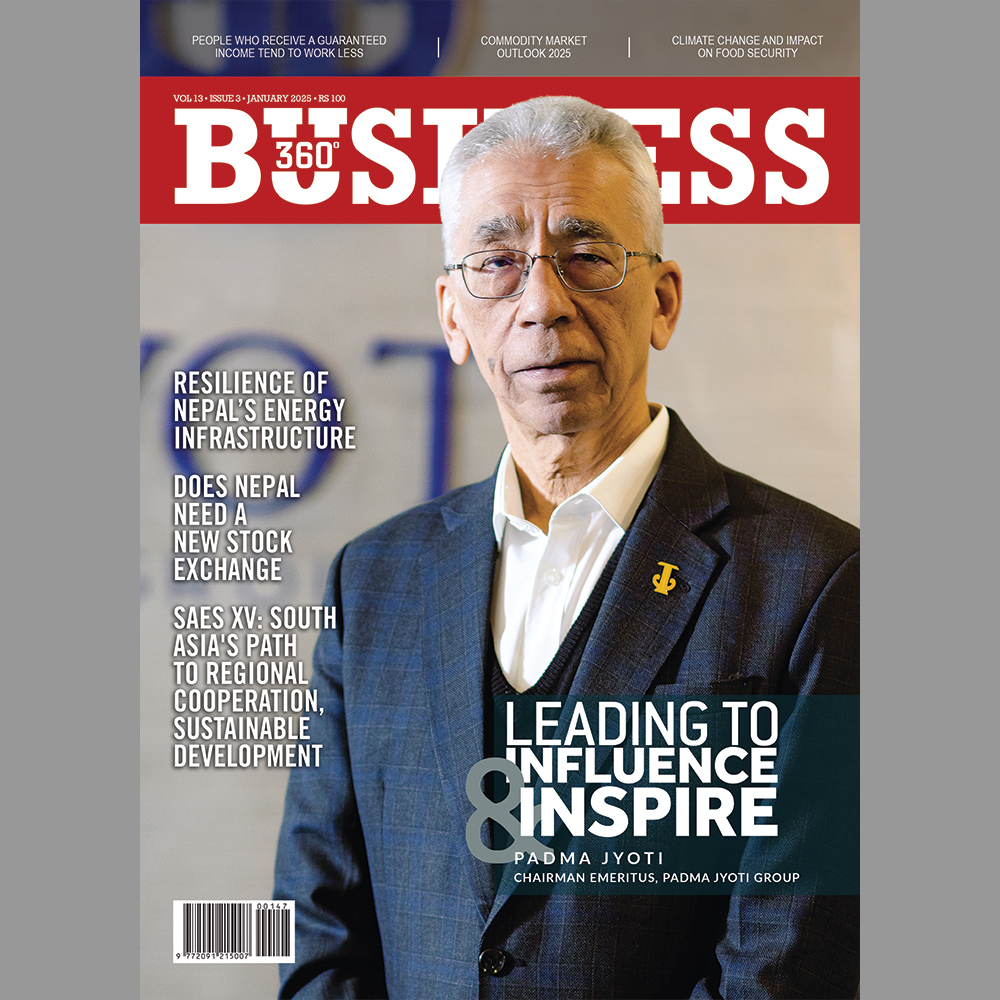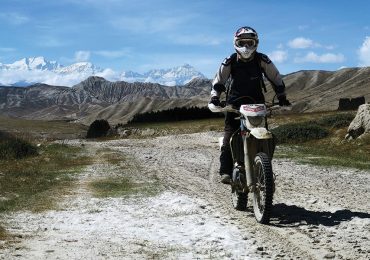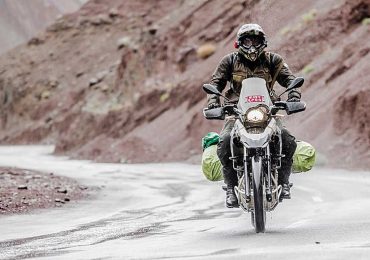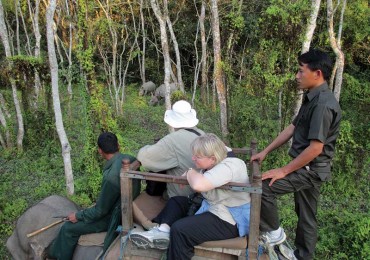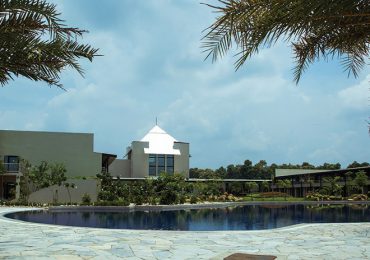
By Ujeena Rana
The first sight that greets guests as they approach the main building to Tiger Palace Resort is the winding pathway with well-dispersed palm trees on both sides. Once the attention is veered off the trees, the façade of the resort comes into full view. Even to an untrained eye, the structure of the building sets itself apart. However, it is just a keyhole glimpse to the magnitude of the surprise elements that await.
A quick observation is the abundance of the earthy colour brown which gives the resort an appearance of being an extension of its surrounding - an apt take on ‘integration with nature’ discourse. Counterbalancing this neutral tone is the sprinkling of bright colours intermittently: blue and orange couches in the lobby, the conspicuous golden chandelier in a modernistic design and green houseplants against white walls.
The interiors are characterised by both white-washed walls and colorful accents. The lobby, deservingly, enjoys the spotlight. You get transported to a different location, different milieu - nothing about the property reminds you of being in Bhairahawa. Practically, the resort should not be in Bhairahawa because it does not look the part. However, that is what Tiger Palace is set on to deconstruct. Concurrently, it creates a benchmark for the service industry.
The casino, part of the resort, lures visitors in scores from across the border. “Indian guests make up to more than 90% of the total numbers,” informs Prabhakar Khadka, Director of Sales & Marketing. Theirs is an integrated resort; the business model heavily relies on the business that the casino does. In order to generate the kind of revenue the establishment expects, they need that business from the Southern neighbour.
Besides, it is not just distant travellers - the room guests – to whom the resort plays host to, even locals visit the property for a cool splash in the pool, sumptuous food and to be part of the plentiful events the resort regularly organises.
Guests visit the resort to enjoy family holidays, leisure time and to attend corporate functions. The resort also promotes itself as a destination wedding hub. Apart from the regular services like the health club and the spa, the establishment also houses the Entertainment Hall where guests can catch up on daily movie screenings; a game parlour where guests can play table tennis, foosball and video games; and in case the parents want to enjoy timeout from their kids, the Cub’s Kingdom provides in-house nannies.
The architectural firm, Space Studio, based in New Zealand gave the resort its bold identity and an unequivocal sense of place. Space Studio has designed hotels, airports, retail in Australia, Fiji, Dubai, New Zealand and Papua New Guinea. A majority of hardwire in the building is from New Zealand itself.
The resort is spread across 17 bighas of land. They claim to have the largest pool (123 m) and the largest casino in Nepal. The brief given to the architectural firm was to go big and bold as Silver Heritage Group wanted the biggest and the best. The idea, in fact, was to build something to a 5-star level.
 Water is yet another dominant element followed by opulent green plants. Bhairahawa, where the resort is located, endures adverse hot climatic conditions so much so that even on a cloudy day, the temperature reaches 33 degrees celsius and humidity is 71%. Understandably, the generous use of water and vegetation is to mitigate heat.
Water is yet another dominant element followed by opulent green plants. Bhairahawa, where the resort is located, endures adverse hot climatic conditions so much so that even on a cloudy day, the temperature reaches 33 degrees celsius and humidity is 71%. Understandably, the generous use of water and vegetation is to mitigate heat.
Volcano Prawn, a specialised dish of Deepak Biswakarma, the head chef at Cabana Avenue, is a favourite of guests. The flavours erupt inside the mouth. It is not a quick bite to be had in a rush. It demands time as it is to be relished one piece at a time. The prawns for the popular dish are outsourced from Thailand. But daily goods and supplies are heavily local. Amit Chatterjee, Head Pastry Chef, informs, “breakfast pastry, farinaceous goods, confectionary - the ice-cream and the chocolates everything is homemade.” Ramro Chowk is where the breakfast buffet, lunch and dinner are laid out for room guests. The Jackpot Buffet is exclusively for casino guests.
The Tiger Palace resort has a casino, hundred rooms (90 deluxe rooms and 10 suites) and two villas at present. Plans are to build an additional block housing 100 rooms. In a perfect situation, the resort has anywhere from 90 to 100 % occupancy which is 100-200 guests in the resort. And in a perfect situation, it would like to see up to 1000 guests in a day at the casino.
With the kind of reception that they have received so far and counting on their clairvoyance, Silver Heritage has started groundwork on Tiger Palace Resort II. They have officially acquired land in Jhapa. Construction will start sometime next year.
Tiger Palace Resort is owned and operated by Silver Heritage Group, a publicly-traded company listed on the Australian Securities Exchange and owns 100% of Tiger Palace Resort via sole ownership of Tiger One Pvt. Ltd. The company is an experienced regional gaming operator with its headquarters in Hong Kong that operates and manages casinos in Nepal (the one at Tiger Palace and The Millionaire’s Club & Casino, Kathmandu under its own license) and in Vietnam (in partnership with a license holder).Tiger Palace Resort has been in operations since September 2017 while the casino has been running since December 2017.
Bhairahawa carries a distinct identity for a multitude of reasons. The distance between Bhairahawa and Sunauli border is 24 kms. The border connects to India’s most populous state, Uttar Pradesh. Bhairahawa is also famous as an industrial hub. There are cement factories, food processing units, noodle factories, pharmaceutical factories, steel rolling plants, distilleries and breweries. Besides, the ambitious Bhairahawa Special Economic Zone (SEZ) project is anticipated to revamp the place. To add to the fanfare, the Bhairahawa International Airport, apparently, is underway to see the light of the day. Further, Lumbini, the birthplace of Lord Buddha, is approximaely 21 kms from Bhairahawa. And now it has the Tiger Palace Resort.
Interview with Brett Model, General Manager
 What made you take up the job?
What made you take up the job?
The first time I visited Tiger Palace was in January 2017. I had met the CEO in Vietnam where I was working at the time. He invited me to see the resort. When I saw the property, I was very impressed. There were a lot of things that I saw as low-hanging fruit, obviously big challenges to be faced but also a lot of things that I could immediately come and fix. I wanted to be part of something that was really ground breaking and new and make an impact on the country. I joined the resort in March 2018.
What were the things you thought needed fixing?
For example, there were a lot of improvements that I saw could be made aesthetically to the building. I thought there was an immediate action that could be taken in terms of sales and marketing tactics and strategies to bring in new businesses and revenue. There were also some cost-saving initiatives that I was looking forward to implement to immediately impact our bottom-line in terms of spending. So bringing in revenue, cutting costs and making some nice changes to the building.
You have worked in China, Macau, Vietnam and Bhutan. How have these experiences helped you in Nepal?
I have spent over 15 years in Asia. Majority of those years were spent in China. To be successful in this part of the world, I think, there are a few things: you need to lead by example and you also have to seek to understand before being understood. When you come to a place like Nepal, you need to quickly figure out how the country operates, how the people operate and then start to impact change. But to do so, you need the right team of people around you. And they need to buy into your motivation as well as inspiration. Building a core team of people that stands by you is important. I can’t do it all by myself.
Is it chiefly the Indian guests that the resort is targeting?
I think the business is going to evolve over time. Right now, we have a mix of Nepali and Indian guests mostly. Our casino guests are majority Indians. Over time, especially, when the international airport opens, we will see a shift to a much more global clientele. I think we will see a clientele heavily influenced by China, potentially Thailand and Korea and other parts of Asia as well. The international airport will be a real game-changer for our business. It’s going to impact us and the country at large. It’s not efficient for Nepal to have just one international airport.
Are you one of those leaders who practice a hands-on approach?
I think it’s almost too hands-on. I am running around this building all day long. I am in the kitchen, I am in the rooms, I am under the bed, on the floor checking to make sure there is nothing left from the last guest. I am trying different foods. You will see me at the purchasing inspection area when the food comes in. I take a knife from my pocket and cut open an onion and check the onion, I check the broccoli. You can ask anyone in the building, they never know where I am going to appear next.

